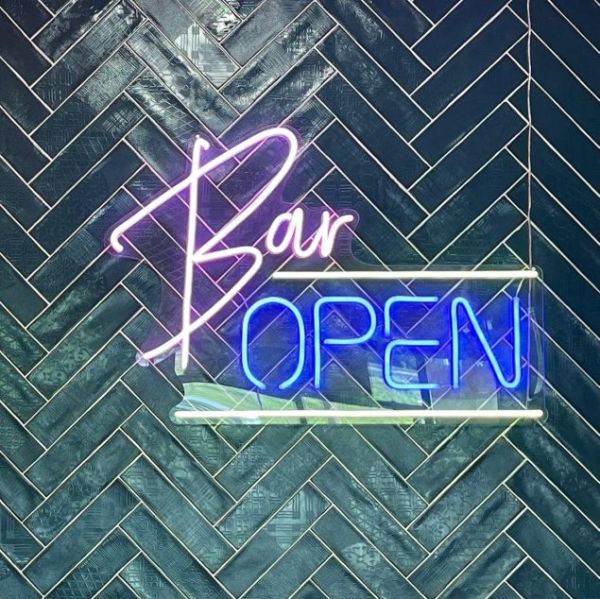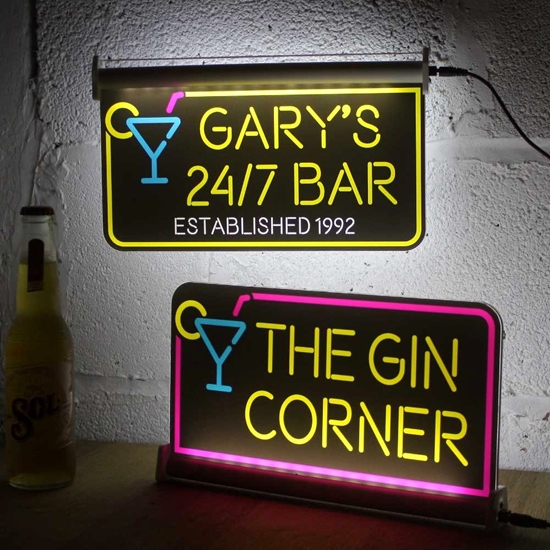New Info To Picking Bar Signs
New Info To Picking Bar Signs
Blog Article
What's The Difference In The Size Of Bar Signs?
The size of bar signs varies depending on the intended purpose, their placement and the overall design aesthetic. This is how the different dimensions affect bar signs' functionality and appeal. Large Signs
Draw attention and become a focal place.
Uses: Exterior branding, main brand signs, or feature wall.
Placement: This is usually placed above entrances, large walls, or on the outside of the bar. It will attract patrons.
Examples: huge neon signs, oversized vintage style signs, or huge wall-mounted signs.
2. Medium Signs
Use for display purposes: to show information or to improve the decor of a room without overpowering it.
Uses : Menu boards and directional signage.
Location: Designed to be visible but does not overwhelm such as behind the bar or over seating areas.
For instance medium-sized chalkboards that feature daily specials or signs made of metal featuring the bar logo.
3. Small Signs
Useful: To add delicate decorative elements or give specific details.
Uses Table signs, small decorative pieces or labels.
Placement: Displays and tables that are close to the eye.
Examples include table number signs, small-framed quotes, or drinks menu cards.
Size Aspects
Visibility
Large Signs are designed to draw attention of passers-by and to establish the bar's presence.
Medium Signs: Balances the need for visibility with space efficiency, delivering crucial information without overwhelming the design.
Small Signs: Ideal for intimate information or close-up details. Helps enhance the customer's experience by putting them at eye level.
Proportion
Large Signs: They should be proportionate to the space so as to not overwhelm smaller spaces. The best choice for spacious or open areas.
Medium Signs - Goes well with most interiors and can be used in a variety of placement.
Small signs are ideal to add detail and be placed in tighter spaces.
Impact
Signs are big and bold. They make a statement. Bar signs can be used to establish a particular tone.
Medium Signs Creates an equilibrium between visibility and decor, contributing to the overall atmosphere while conveying vital information.
Small Signs (Signs): Adds detail and a sense of humour to a visual experience.
Practicality
Large Signs: These sign require large mounting solutions and they are more costly due to their dimensions.
Medium Signs: Simple to put up, move and allow for changes in design.
Small Signs. Flexible, simple to replace and update. Great for busy environments.
Functionality
Large Signs: Mostly to draw attention and increase visibility.
Medium Signs are both functional as well decorative. They provide vital information and improve the appearance of your property.
Small Signs are essential and give detailed information. They can also be a part of an overall theme or style.
The ideal size of bar signage depends on their intended purpose, layout, as well as the effect on the patrons. The balance between these factors ensures that the signs are effective in contributing to the atmosphere of the bar and the operational requirements. Follow the most popular bar signs for home bar blog for more recommendations including indoor bar signs, personalised pub signs for sale, bar sign outdoor, bar sign outdoor, modern pub sign, hanging tavern sign, bar sign hanging, novelty bar signs, buy bar signs, pub signs personalised and more.
What Is The Main Difference Between Bar Signs And Other Signs Regarding Light?
Bar signs differ in their lighting. This can affect the appearance, atmosphere and the impact. Lighting variations have a major impact on bar signs. Neon Signs
Characteristics: Bright, colorful, classic.
Lighting: Uses gas tubes with neon-filled gas that emit lighting when they are charged.
The uses for this product are It's great to create an old-fashioned or retro feel.
Advantages: It's highly visible from the distance.
It's fragile, and repairs could be expensive.
2. LED Signs
Characteristics: Energy-efficient, versatile, modern.
Lighting: Make use of LEDs to produce bright and vibrant lighting.
Uses : Indoor and outdoor signs are available in conjunction with an adjustable display and dynamic lighting effects.
Benefits: LEDs last a long time, are efficient in energy use, and are programmable with animated or color changes.
Disadvantages : Can be costly initially, but can save on energy and maintainance costs.
3. Backlit signs
Characteristics: Elegant, sophisticated, subtle.
Lighting: Use light sources such as fluorescent and LEDs behind transparent surfaces to create soft, diffused light.
Uses: Typically for bar menu boards, signs, as well as branding components.
Benefits: Gives a neat and professional appearance, improves the readability in dim light.
Advantages: More complicated installation and higher upfront cost.
4. Signs with Edge-Lit
Characteristics: Sleek, contemporary, stylish.
Lighting: Illuminates the edges of the acrylic sign panel.
Uses: Suitable for contemporary, minimalist designs, often used to create directional or informative signs.
Features: Creates sophisticated, distinctive appearances. It's also energy efficient.
Design styles are not restricted to certain designs.
5. Ambient/Accent Lighting
Characteristics: Subtle, atmospheric, decorative.
Lighting: Make use of indirect light sources to highlight or accentuate indications.
Uses: Creates a calming ambience, and is frequently used to complement themed decor or art.
Benefits: Creates a cosy and welcoming atmosphere.
The direct light provided might not be sufficient to read easily.
6. Marquee Signs
Characteristics: Bold, theatrical, eye-catching.
Lighting: Multiple light bulbs or LEDs are used around the sign's edges.
Uses: Signs on the outside, event promotion, and vintage-style cinema are popular.
Advantages: Attractive and visible.
Cons: It is expensive and requires regular maintenance.
7. Projection Signs
Characteristics: Dynamic, innovative, versatile.
Lighting: Projectors are used to cast light and images onto a surface.
Uses: It can be used to create events and promotions that are only temporary.
Simple to alter There is no need to use physical signs.
Disadvantages: Requires a controlled lighting environment, and can not be as effective in bright lighting.
8. Fluorescent Signs
Characteristics: Bright, cost-effective, traditional.
Lighting Tubes that emit light for illumination.
Commonly employed to create larger indoor or outdoor signs.
Benefits: Bright and efficient for large signs, relatively cost-effective.
Advantages
Lighting Factors to Consider
Visibility
Neon Signs and LED Signs They are excellent for grabbing attention, especially in the evening.
Backlit signs and edge-lit signage These are great for enhancing the visibility of your sign and giving it a more refined appearance.
Energy Efficiency
LED Signs: Highly energy-efficient and long-lasting.
The neon and fluorescent signs are less efficient in energy use, with neon being more delicate.
Aesthetic Appeal
Neon and Marquee Signs: Perfect for retro and vintage styles.
For clean, modern designs, backlit and edge-lit signs are perfect.
Ambient Lighting: Provides a more relaxed and comfortable environment.
Maintenance
LED signs are low-maintenance and last for a long time.
Neon and fluorescent signs may require frequent maintenance and repairs.
Cost
LED Backlit Signs: High initial costs, but lower operating costs.
Fluorescent signs have lower initial costs, but higher costs for energy in the long run.
Flexibility
Projection and LED Signs that can be programmed: Provide high flexibility in moving display and interactive content.
Traditional Signs: Less flexible but often provide a specific desired appearance.
The right lighting can create the ideal atmosphere and to effectively communicate with the patrons. Take a look at the best bar signs for home for site info including personalised garden pub sign, pub sign hanging, pub sign hanging, buy bar signs, personalised home pub sign, pub signs made, the pub sign, personalised hanging bar sign, pub signs made, home made bar sign and more.
How Do Bar Signs Differ In Terms Of Regulations?
The bar sign is subject to different regulations, imposed by the local or federal authorities to protect public health, aesthetic standards, compliance with zoning laws, and to ensure the welfare of the public. Below is how bar signs differ according to the rules: 1. The size and location of bar signs is regulated.
Zoning Laws: Regulations specify the location of signs and their height, size and distance from roads, property lines or adjacent buildings.
Historic Districts - Signs may be restricted in size, style, and materials to protect certain areas' historical character.
2. Illumination Restrictions
Light Pollution: To reduce light pollution and preserve nighttime environments, regulations may restrict the luminosity of signs, their color and the time they last.
Safety Considerations Signs cannot cause glare or distract pedestrians or drivers particularly when they are placed close to the road.
3. Signage Content
Alcohol Advertising: Alcohol advertising is prohibited in certain jurisdictions. This is a concern for images or material that might be appealing to minors or promote excessive drinking.
Health Warnings: Laws may require health warnings regarding the dangers of drinking alcohol or smoking.
4. Historic Preservation Regulations
Architectural Compatibility: Signs within historic districts must be compatible with the architectural style and characteristics of the area, often needing the approval of preservation boards or commissions.
Material and Design: Signs that are historically significant may have restrictions on the materials used as well as the design and color scheme.
5. Sign Permitting Process
Permit The bar owners must be granted permits prior to putting up or modifying signs, which might require the submission of plans, payment of fees and getting approval by local authorities.
Code Compliance: Signs should comply with construction codes as well as fire safety regulations and accessibility standards to ensure the safety of the public and accessibility for individuals who are disabled.
6. Sign Removal Repair, Maintenance and Removal
Maintenance requirements: It's the bar's responsibility to keep their signage in good working order. This means ensuring that they're structurally sound, safe, and comply with all rules and regulations.
Signs that are abandoned: Regulations could regulate the removal of old or decaying signs to avoid blight and preserve the aesthetic appeal of the area.
7. Digital Signage Regulations
Content Restrictions. Laws may restrict what content can be displayed on digital signage. For example, they might prohibit flashing lights or images that offend.
Operational Limits Regulations may limit the brightness of digital signs, frequency and motion to reduce visual obstructions.
8. Enforcement and Penalties
Inspections: Local authorities inspect signs periodically to make sure they're in compliance the signage regulations. They will issue citations in the event of there are any violations.
Penalties: If you fail to comply penalties can include citations, fines, or even a fine. They can also include the removal of signs, or to modify them or even legal action.
9. Sign Variance Process
Bar owners can apply for Variances: Bar owners may apply for variances to deviate the regulations for signs that apply to all establishments. They must prove that they have a legitimate justification for their decision and limit any negative effects on aesthetics or safety.
Public Input: Certain issues may need public hearings or input from residents, neighboring property owners, or business associations.
10. Community Input, Engagement and Engagement
Public Consultation: Some authorities involve local residents in the design of regulations for signage through public meetings, surveys, or stakeholder meetings.
Sign regulations could have community Benefits. Sign regulations can include provisions that enhance the appearance of signs, promote local business, or help revitalize neighborhoods.
Understanding and adhering to the regulations for signage will allow bar owners to ensure their signage is beneficial to the surrounding community, abide with the legal requirements and reduce the chance of being fined and penalties. Take a look at the top rated what do you think about pub bar signs for more advice including bar wall signs, bar wall signs, garden bar sign personalised, pub signs for home bars, home garden bar signs, pub signs personalised, personalised outdoor bar signs, gin bar sign, personalised outdoor bar signs, hanging home bar signs and more.